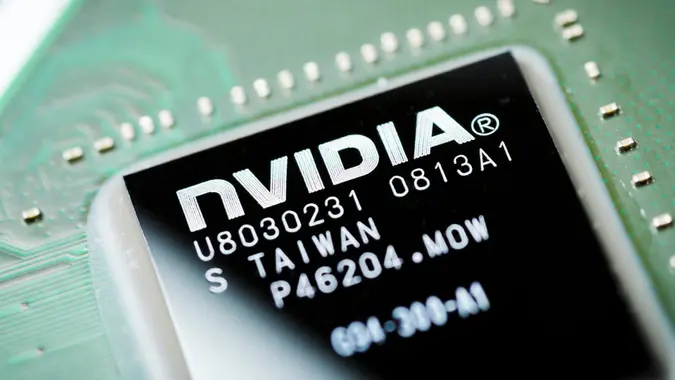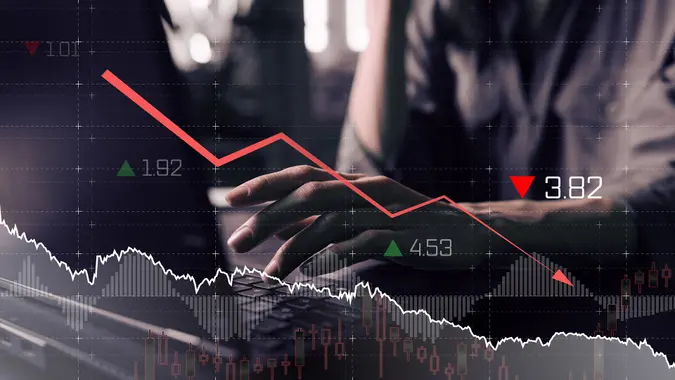Stocks vs. Bonds: How To Choose the Best Investments

Commitment to Our Readers
GOBankingRates' editorial team is committed to bringing you unbiased reviews and information. We use data-driven methodologies to evaluate financial products and services - our reviews and ratings are not influenced by advertisers. You can read more about our editorial guidelines and our products and services review methodology.

20 Years
Helping You Live Richer

Reviewed
by Experts

Trusted by
Millions of Readers
You’ve heard the terms stocks and bonds, and you know the key to good investing is diversifying your portfolio. But what are stocks and bonds, exactly? How do you choose between them, or should you include both? Understanding the difference between stocks and bonds will help you figure out where to invest your money.
Here are some important points to know:
- Stocks and bonds should be part of a diversified investment portfolio.
- Owning stock is like owning a small part of a company.
- A bond is a loan you give to the issuing organization.
What Is a Stock?
Stocks and bonds are often lumped together, leading many people to believe they’re the same thing, or at least similar. They complement each other, but they aren’t all that similar.
A stock is a tiny share of a company. When you buy stocks, you own a part of the corporation. This entitles you to a share of the company’s profits if there are any. Of course, if the stock price goes down, you lose money.
If you were to buy 100 shares of GameStop, you would own a tiny portion of the company. This could earn you a lot of money — GameStop surged to a share price of $347.51 on January 27, although it’s fluctuated down and back up since then. Most stocks don’t rise that exponentially — the average return rate for the stock market is about 10%.
When talking about the stock market, investors are usually referring to the S&P 500. This is a collection of 500 of the largest U.S. stocks, which is considered a good indicator of overall market performance.
What Is a Bond?
A bond, on the other hand, is like a loan you give to a company. Companies issue bonds when they want to raise money. The company issuing the bond agrees to pay you an agreed-upon interest rate for the privilege of using your money. You don’t own any part of the company.
Unlike stocks, a bond’s interest rate isn’t affected by the performance of a company. If you agree to lend a business $1,000 at 3% interest and it has a banner year, you still make only that 3% interest. However, if a company goes completely bankrupt and can’t pay its debts, it won’t pay your loan back, either.
How To Choose the Best Investment for You
The best interest rate on some of the top high-yield savings accounts is about .60%, and the average interest rate on a bond is currently 1.06%, although the rate has been as high as 3.15%. Given that the average return on the S&P 500 is about 10%, why doesn’t everyone just invest in the stock market?
When you invest in the stock market, the average rate of return is roughly 10%, but it fluctuates quite a bit. Consider this table on the rate of return for the past 20 years of the S&P 500:
| Year | Rate of Return |
|---|---|
| 2000 | -10.14% |
| 2001 | -13.04% |
| 2002 | -23.37% |
| 2003 | 26.38% |
| 2004 | 8.99% |
| 2005 | 3.00% |
| 2006 | 13.62% |
| 2007 | 3.53% |
| 2008 | -38.49% |
| 2009 | 23.45% |
| 2010 | 12.78% |
| 2011 | 0.00% |
| 2012 | 13.41% |
| 2013 | 29.60% |
| 2014 | 11.39% |
| 2015 | -0.73% |
| 2016 | 9.54% |
| 2017 | 19.42% |
| 2018 | -6.24% |
| 2019 | 28.88% |
| 2020 | 15.76% |
Some years, the S&P 500 gives you a great return on your investments. Look at 2003, 2009, 2013 and 2019. Double-digit return rates are certainly much better than what you would earn from bonds or savings accounts. However, the financial crisis of 2008 caused investors to lose a whopping 38.49%. That’s difficult to recover from, and it leaves some people leery about investing in the stock market at all.
It’s also important to realize that these numbers reflect the stock market as a whole. If you invest in an individual company, your return could be much higher or lower.
Why Don’t More People Invest?
About 55% of Americans own stock, which isn’t terrible, but it could be better. With inflation projected to be about 2.24% in 2021, you’re losing money anytime you put it in a savings account. If you need quick access to your money, though, a savings account provides that.
Pros and Cons of Investing in Stocks vs. Bonds
Bonds give you a better rate of return than a savings account. They’re considered a more conservative investment than stocks because unless the lending company goes completely bankrupt, you’ll get the interest rate that you agreed to when you bought the bond.
Some people believe you need a minimum amount of money to invest, and it’s difficult for them to find the extra cash. There’s also the issue of liquidity — if you’re struggling to get by, you might need access to your money at any given moment.
Weighing Risk
The chart above indicates that the S&P 500 index fluctuates a great deal. To be a successful investor, you should be prepared to ride out those fluctuations. It can be extremely stressful to watch your investment accounts plummet, but eventually, you will recoup your losses. Even if you invested in the stock market the day before the market crash in 1929, you would eventually have broken even by 1936.
If you’re a risk-averse investor, consider either mutual funds or bonds. Both of these offer less risk than investing directly in the stock market. Age is another factor. The younger you are, the longer you have to recoup your losses — if there are any — and therefore you can take on more risk.
How To Buy Stocks
Here are some tips to help you get started:
Open an Account at a Brokerage
You can find many online brokerages, and it’s as easy as opening a bank account. You complete an application, provide proof of your identity, and then either mail a check or transfer funds electronically. Such accounts allow you to manage your own investments and have lower fees than a paid stockbroker who makes recommendations for you. On the other hand, this could be intimidating for beginners.
Use a Robo-Advisor
You can invest with an app such as M1 or Robinhood. These are called robo-advisors, and they offer automated investing platforms. You answer questions about your goals, and artificial intelligence does the rest. Since no people are involved, fees are generally very low, and you can often get started for as little as $5.
How To Buy Bonds
You can either buy bonds directly from the federal government, which sells them at quarterly auctions, or you can buy them from a broker, the same way you would buy stocks. You can also buy them through an exchange-traded fund. An ETF is a collection of securities that track an underlying index. You can get started with a much smaller investment than with traditional bonds. ETFs don’t mature, so it’ll be up to you to determine when you sell.
Advice
Both stocks and bonds have a place in anyone’s portfolio. They accomplish different things: A bond gives you a small stream of income through interest, and stocks make money over time. Investing is easier than it used to be, thanks to online brokers, robo-advisors and apps. You can get started for as little as $25. Figure out your risk tolerance and your goals, and jump in.
Information is accurate as of Mar. 15, 2021.
Our in-house research team and on-site financial experts work together to create content that’s accurate, impartial, and up to date. We fact-check every single statistic, quote and fact using trusted primary resources to make sure the information we provide is correct. You can learn more about GOBankingRates’ processes and standards in our editorial policy.
- Vanguard. "What Is a Bond?"
- U.S. News Money. 2021. "Best Savings Accounts and Rates."
- YCharts. "U.S. 10-Year Government Bond Interest Rate."
- Gallup. 2019. "What Percentage of Americans Owns Stock?"
- Statista. 2021. "U.S. - Projected Inflation Rate 2008-2024."
- Yahoo Finance. 2020. "42% of People Say This Is Why They Aren't Investing."
- CNN Money. "How To Buy Bonds."
- Charles Schwab. 2020. "The Nuts and Bolts of Bond ETFs."
 Written by
Written by  Edited by
Edited by 

























